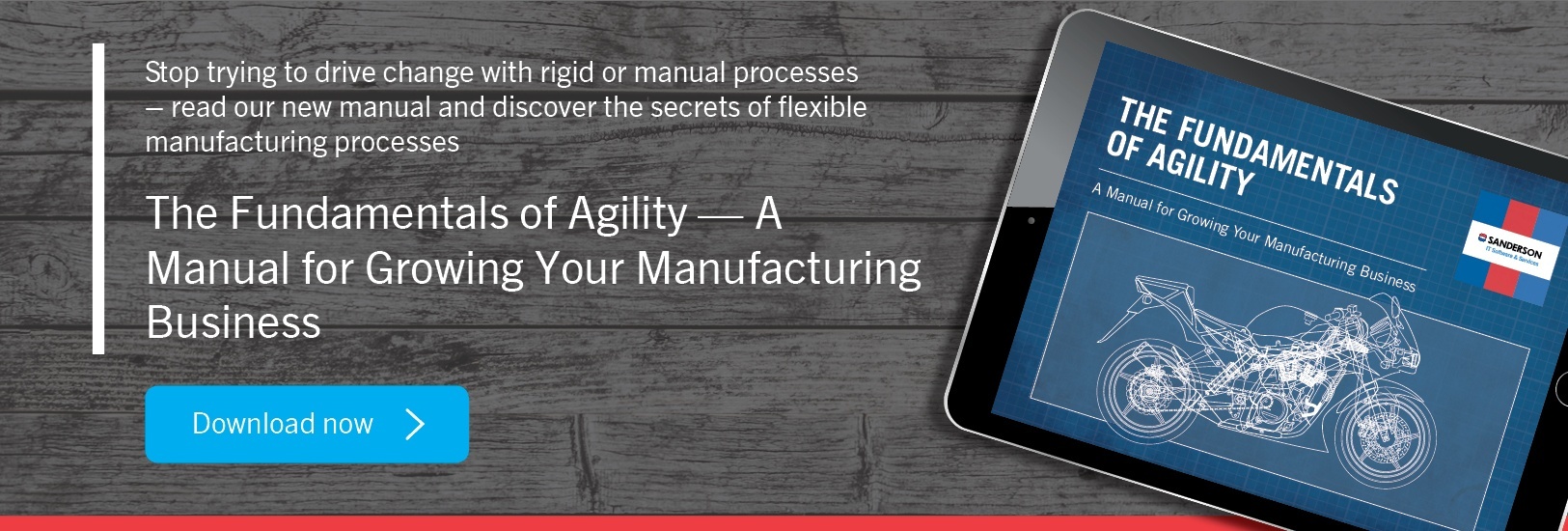Embrace Change and Succeed – The Agility ERP Checklist for Manufacturers
/Embrace%20Change%20and%20Succeed-header%20copy.jpg?width=777&height=348&name=Embrace%20Change%20and%20Succeed-header%20copy.jpg)
Agile manufacturing is crucial to any organisation wishing to secure prosperity and success in today’s fast-moving markets. Can you tick everything off on our ‘agile ERP’ checklist?
For too many manufacturers, unless they are forced to make an organisational change – for example a current IT system fails or they are subject to an acquisition – they are unlikely to do so.
But organisations that can think strategically, and implement new processes to meet upcoming challenges and market changes, have a better chance of long-term success.
The following checklist may help with your thinking:
Basing decisions on up-to-date information
If management is using data from various arms of the business in order to make either operational or strategic decisions, how long is it taking to collate? If this information is recorded on a variety of incompatible systems, or even manually, there will be inevitable delays while it is brought together.
Action point – Evaluate whether your decision-making is as accurate or as timely as it should be.
/Basing%20decisions%20on%20up-to-date%20information.jpg?width=777&height=80&name=Basing%20decisions%20on%20up-to-date%20information.jpg)
Instructions are slow to take effect
Once decisions have been made, how soon are they translated into action? The way instructions are transmitted across a manufacturing organisation can have a significant impact on the effectiveness of the original decision.
Action point – Make sure your manufacturing business is using systems that staff can use to act on directions immediately.
/Instructions%20are%20slow%20to%20take%20effect.jpg?width=777&height=80&name=Instructions%20are%20slow%20to%20take%20effect.jpg)
Siloed operational expertise
If your organisation is relying on outdated or bespoke IT systems, what potential issues do you face in ensuring that these systems continue to operate effectively without the staff who are currently responsible for them? As experienced older workers start to retire, many manufacturers face the loss of the expertise necessary for the smooth running of their business.
Action point – Identify any legacy systems in your manufacturing business and make sure they are not holding you back.
/Siloed%20operational%20expertise.jpg?width=777&height=80&name=Siloed%20operational%20expertise.jpg)
Supply chain visibility
It is becoming increasingly important for companies to have a complete picture of who their suppliers – both direct and indirect – are, for both reputational and regulatory reasons.
Being able to integrate your supply chain into your own IT systems will not just make your procurement activities more efficient – it can also provide valuable peace of mind.
Action point – Ask your supply chain managers how clear their partner visibility and communications are.
/Supply%20chain%20visibility.jpg?width=777&height=80&name=Supply%20chain%20visibility.jpg)
Identifying high-priority problems
From customers paying late to goods not being dispatched on time or mistakes with orders, there is a host of issues that can affect your company’s profitability.
Action point – Ask yourself this question – are the problems that are the biggest threat to your organisation being identified quickly enough and prioritised for action?
/Identifying%20high-priority%20problems.jpg?width=777&height=80&name=Identifying%20high-priority%20problems.jpg)
Managing shifts in customer demand
A key development of recent years has been the increasing demand for product customisation. With more and more clients seeking bespoke configurations, the most successful manufacturers will be those which can meet these changes in requirements – without sacrificing profitability. A coherent view of profit-per-product is essential.
Action point – Assess how quickly your existing processes can deliver accurate quotations and lead times for custom orders. Is your existing ERP system giving you sufficient support?
/Managing%20shifts%20in%20customer%20demand.jpg?width=777&height=80&name=Managing%20shifts%20in%20customer%20demand.jpg)
Stop trying to drive change with rigid or manual processes – read our new manual and discover the secrets of flexible manufacturing processes
Topics: Manufacturing




